Have you ever wondered why despite getting a decent amount of traffic to your website, the conversions seem to be slipping away?
It could be a case of the high bounce rate.
In today’s highly competitive digital landscape, where user attention spans are shorter than ever, bounce rate has emerged as a crucial metric that can make or break your online success.
Bounce rate refers to the percentage of visitors who navigate away from your website after viewing only a single page, without taking any further action or accessing another page of your website in the same visit.
Shockingly, studies have shown that the average bounce rate across all industries hovers around 50%.
That means half of the visitors leave immediately, without exploring what you offer!
Imagine the untapped potential and revenue loss that could be prevented by reducing this bounce rate.
Website bounce rate matters for owners because it provides valuable insights into the effectiveness of their content.
A high bounce rate indicates that visitors need help finding what they’re looking for or experiencing a poor user experience, resulting in missed opportunities for conversions, lead generation, or engagement.
Moreover, search engines like Google also consider bounce rate as a crucial factor in determining the relevance and quality of a website.
A high bounce rate can negatively impact your search engine rankings, making it harder for potential customers to find you organically.
In a nutshell, reducing the bounce rate is vital for maximizing user engagement, improving conversions, enhancing search engine visibility, and ultimately driving the success of your digital marketing efforts.
By addressing the issue of bounce rate head-on, you can captivate your audience, make them stay longer, and increase the likelihood of conversions.
So, let’s check out the actionable reducing bounce rate strategies and proven techniques that can help you reduce your website bounce rate and transform it into a magnet for engaged and satisfied visitors.
What is Bounce Rate?
Consider the following scenario: you open a book, rapidly read the first page, and then dismiss it without even turning to the next page.
In the digital world, that is exactly what a bounce rate is!
According to Google, in Analytics a bounce happens when a visitor appears on your website but does not engage with it further.
It’s as if they went to a single-page party and then departed without interacting with any other sites or initiating any activities that connect with the Analytics server.
So, picture this: a person visits your website, examines one page, and then decides to leave without clicking any links, submitting forms, or digging deeper into your material.
That’s a classic example of bounce!
Bounces are important metrics or measures since they show a visitor’s lack of interest and involvement.
Understanding website bounce rates may provide insight into how efficiently your page catches and holds visitor attention.
How to Calculate a Bounce Rate?
Moreover, bounce rate is a statistic that calculates the percentage of users that arrive at your website and then leave without taking any further action or traveling to another page on your site.
It is calculated by dividing the number of single-page sessions by the total number of sessions on your website.
It’s worth noting that not all bounces are terrible.
In other circumstances, a high bounce rate is acceptable or even expected, such as when visitors arrive on a contact page and instantly locate the needed information, prompting them to contact you without browsing other sites.
Decoding Bounce Rates: High Bounce Rate vs Low Bounce Rate and Their Significance
The amount of engagement and user experience on your website makes the difference between a high and a low bounce rate.
- High Bounce Rate
A high bounce rate, often greater than 70%, shows that a substantial part of your visitors is abandoning your site without further research.
This might be due to various factors such as irrelevant material, long page load times, unclear navigation, or an unappealing design.
A high bounce rate indicates that your website is failing to capture users’ interest or match their expectations.
- Low Bounce Rate
A low bounce rate, ideally less than 40%, suggests that visitors are engaging with your website, exploring numerous pages, and spending more time on it.
This indicates that your website is offering relevant and engaging information, a pleasant user experience, and successfully attracting users’ attention.
Average website bounce rates vary based on the type of domain.
According to various surveys, a blog or content-focused site, for example, may have a higher average bounce rate of 70-90%, whereas an eCommerce or service-based site may strive for a lower bounce rate of 20-40%.
It is vital to remember, however, that these criteria might vary greatly depending on the industry, target audience, and website goals.
Setting reasonable bounce rate targets based on your circumstances is critical, as is striving for constant progress.
Understanding the distinction between high and low bounce rates is critical for identifying areas for improvement, optimizing user experience, and ultimately increasing engagement and conversions on your website.
In the sections that follow, we’ll look at ideas and approaches for efficiently lowering bounce rates and improving the overall performance of your website.
Also Read: Content Marketing Strategy Guide
Factors Affecting Bounce Rate
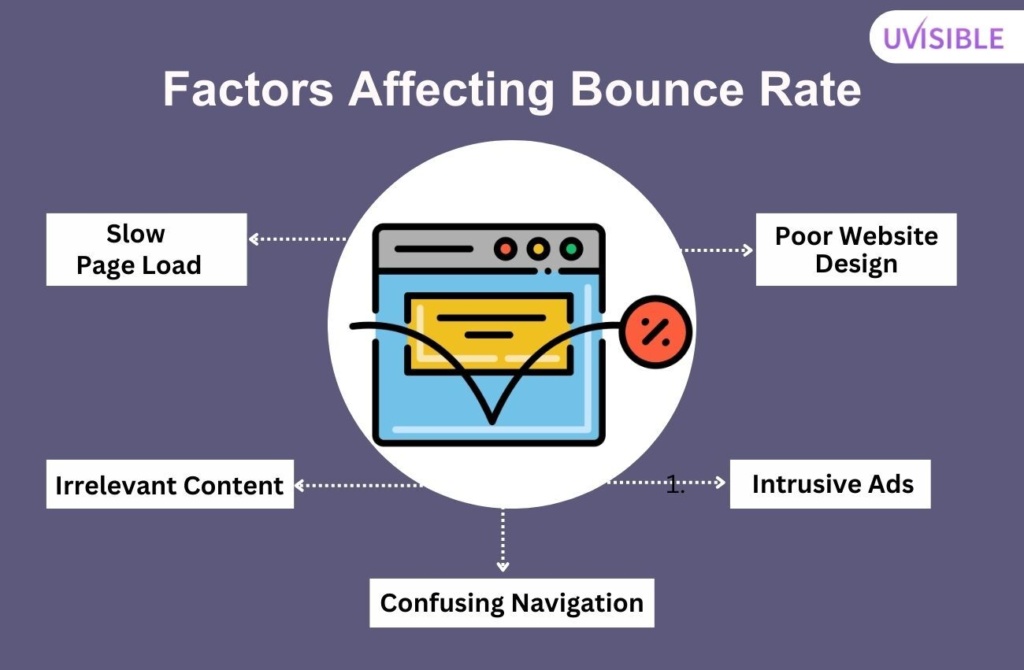
Bounce rate is a very critical metric for your website which cannot be neglected if you aim to rank higher in search results.
Certain factors play a crucial role concerning the bounce rate as they aid in determining whether it will be at a high or a low.
Do check out the list of factors affecting the bounce rate:
Slow Page Load
When your website takes a long time to load, users become irritated and are more likely to abandon it.
Large picture sizes, too many plugins, or ineffective hosting can all contribute to poor load times.
Hence, image SEO optimization becomes extremely important to reduce bounce rate.
According to research, a 5-6 second delay in connection speed can raise “peak frustration” by more than 26% and reduce engagement by 8%.
Slow load time leads to a negative user experience, greater irritation, and a likelihood of a high bounce rate.
Poor Website Design
Visitors might be turned off by an ugly or outdated design, causing them to leave.
Users associate a badly designed website with a lack of legitimacy, forcing them to abandon the site and look for alternatives.
Cluttered layouts, difficult-to-read typefaces, or an overbearing color scheme can all contribute to a terrible user experience.
Furthermore, a visually ugly or outdated design fails to catch the attention of visitors and represent expertise.
Irrelevant Content
Visitors looking for information arrive at your website with certain expectations and interests.
Visitors will rapidly depart if your material does not match what they are looking for.
Understanding your target audience and offering relevant, meaningful, and engaging content are critical components of lowering bounce rates.
Confusing Navigation
When surfing a website, visitors need simplicity and ease of use.
Complex or illegible navigation menus make it difficult for visitors to find what they are looking for.
Users may get dissatisfied with your site if it lacks intuitive organization and obvious routes.
Intrusive Ads
You might have noticed websites that have ads appearing before the real content starts.
Such ads interfere with the user experience and obstruct content visibility which might drive users away.
Visitors are more likely to abandon your site if they see distracting advertisements that interfere with their ability to consume or interact with your content.
Ads should be used in moderation, ensuring that they are relevant, non-intrusive, and improve rather than detract from the user experience.
How to Reduce Bounce Rate?
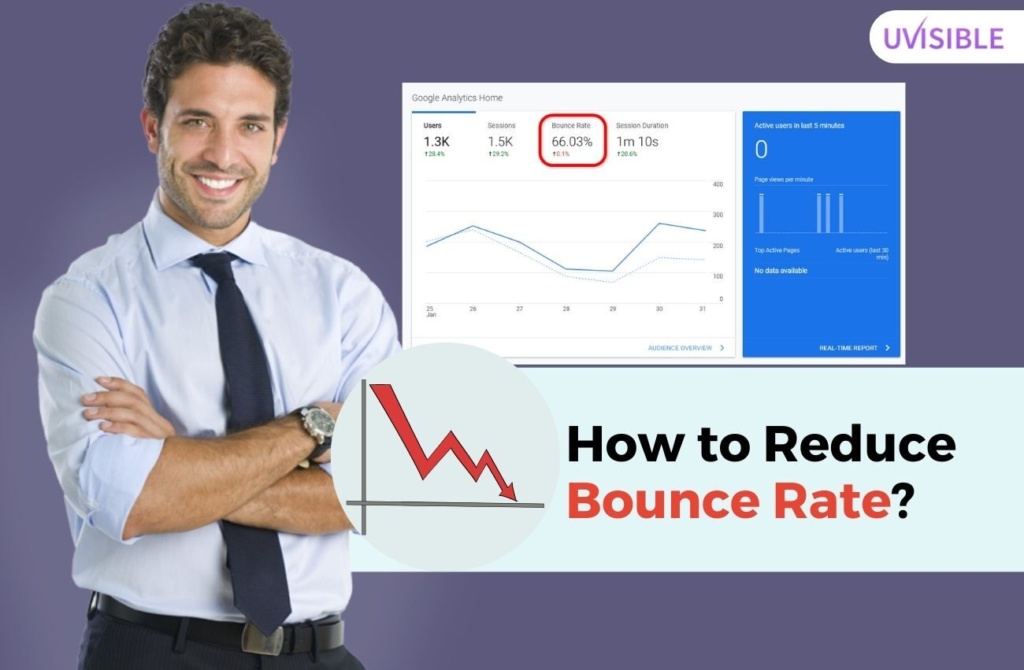
Till now, we have understood what is bounce rate and the factors affecting it, now it’s time to find out various ways to reduce bounce rate.
Reducing the bounce rate will play a crucial role in sustaining the traffic and increasing the chances of sales for your business.
Improving Website Speed, Design, and Performance
Website speed, design, and performance play a vital role in reducing bounce rates and keeping visitors engaged.
Think about it – would you stick around on a website that takes forever to load? Probably not.
By optimizing your website for faster loading times, you can capture visitors’ attention and prevent them from bouncing.
- Take a look at your image sizes and consider compressing them without sacrificing quality.
- Minify your code to reduce unnecessary scripts and CSS.
- Leverage browser caching techniques to make subsequent visits faster.
These optimizations can significantly improve your website’s speed and create a smoother browsing experience for your visitors.
Some while ago, an eCommerce website approached us with the issue of a high bounce rate on their website.
As an experienced Ecommerce Digital Marketing Services Agency, we conducted a thorough analysis using tools like Google Analytics and identified that slow page load time was one of the main reasons for the high bounce rate.
By compressing their images, implementing browser caching, and optimizing their code, we managed to decrease their bounce rate by 30%, resulting in improved engagement and conversions.
Enhancing User Experience
A great user experience is key to reducing bounce rates.
When visitors land on your website, they want to navigate effortlessly, find the information they’re seeking, and have a visually appealing experience.
By focusing on intuitive navigation, clear calls to action, and an attractive design, you can create a seamless and enjoyable user experience that encourages visitors to explore your site further.
Consider implementing a user-friendly menu structure, clear and concise labels for your navigation links, and prominent calls to action throughout your website.
Pay attention to the visual design, ensuring it aligns with your brand and engages visitors visually.
A visually appealing website can enhance trust and credibility, making visitors more likely to stay and explore.
For example, in our initial years as a digital marketing agency, we noticed a high bounce rate on our landing page.
After conducting user testing and gathering feedback, we realized that the navigation was confusing, leading visitors to leave without further engagement.
By redesigning our navigation, and making it more intuitive and user-friendly, we saw a significant decrease in our bounce rate and an increase in conversions.
Remember, a positive user experience goes a long way in reducing bounce rates and keeping visitors engaged with your website.
Continuously analyze user behavior, gather feedback, and make iterative improvements to enhance the overall experience.
Creating Relevant and Engaging Content
One of the most effective ways to reduce bounce rates is by creating relevant and engaging content.
When visitors land on your website, they expect to find information, products, or solutions that are relevant to their needs and interests.
If your content fails to meet their expectations, they’ll likely leave without further exploration.
- Start by understanding your target audience and their pain points.
- Develop content that addresses their needs, provides value, and keeps them engaged.
- Use compelling headlines, well-structured paragraphs, and relevant visuals to make your content visually appealing and easy to consume.
Let’s consider a scenario where you run a ‘Digital Marketing Blog’ and notice a high bounce rate on your articles related to SEO, PPC, and so on.
After analyzing user behavior, you discover that users are expecting detailed guides and tips and tricks on various SEO strategies but find only generic and short descriptions.
By reworking your content to include topics like; SEO Outsourcing Guide and so on, you can capture visitors’ interest, reduce website bounce rates, and increase the time they spend on your website.
Remember, content is king, and creating content that resonates with your audience is crucial for reducing bounce rates and keeping visitors engaged.
Continuously analyze your content performance, gather feedback, and make improvements to provide the most relevant and valuable information to your visitors.
Optimizing Website Landing Pages

Landing pages are critical elements of your website that often serve as entry points for visitors.
Optimizing your landing pages can have a significant impact on reducing bounce rates and increasing conversions.
A well-optimized landing page should align with visitors’ expectations, clearly communicate the value proposition, and provide a clear path for further engagement.
Start by defining a specific goal for each landing page. It could be signing up for a newsletter, downloading an e-book, or making a purchase. Keep the design clean and focused, with a clear call to action that stands out.
Consider an example of an eCommerce store that offers a 20% discount for first-time customers.
They create a landing page specifically targeting first-time visitors, clearly communicating the discount and providing a simple form to sign up.
By optimizing the landing page with a compelling headline, persuasive copy, and a visually appealing design, they can reduce bounce rates and increase the conversion rate of first-time visitors.
Remember to continuously test and optimize your landing pages, analyzing user behavior and making data-driven improvements.
By understanding what resonates with your audience, you can create landing pages that entice visitors to take the desired action, ultimately reducing bounce rates and increasing conversions.
Implementing A/B Testing
A/B testing is a powerful technique to optimize your website and reduce bounce rates.
By creating different versions of your web pages and testing them with different segments of your audience, you can identify which variations perform better in terms of engagement and conversion rates.
For example, let’s say you have a landing page with a prominent call to action button.
Through A/B testing, you create two versions of the landing page: one with a green button and the other with a blue button.
By showing each version to different segments of your audience and analyzing the bounce rates and click-through rates, you can determine which color performs better and drives higher engagement.
By consistently running A/B tests on various elements of your website, such as headlines, images, layouts, or forms, you can optimize your website bounce rate for better user engagement and ultimately reduce bounce rates.
Utilizing Exit Intent Strategies
Exit intent strategies can help capture visitors’ attention and prevent them from leaving your website.
These strategies involve displaying targeted pop-ups or overlays when users show signs of leaving, such as moving their cursor toward the browser’s close button.
For instance, an eCommerce website may show a pop-up offering a limited-time discount code or a free shipping incentive when a visitor is about to leave.
By providing a compelling reason to stay, visitors may be encouraged to explore further and make a purchase, thus reducing bounce rates.
Remember to use exit intent strategies thoughtfully, ensuring they provide value to the visitor and are not overly intrusive.
Strategic and well-designed pop-ups can effectively decrease bounce rates and retain visitors.
Utilizing Widget Wisdom

While sidebar widgets and promotions can be useful for cross-promoting content or products, excessive use can clutter the visual layout and distract visitors.
This can result in higher bounce rates as visitors may find it difficult to focus on the main content or navigate through the website.
Ensure that sidebar widgets and promotions are relevant, non-intrusive, and complement the overall user experience.
By keeping them concise and sparingly using them, you can maintain a clean and focused layout that encourages visitors to stay and explore.
Command Attention with CTAs
A strong and effective call to action (CTA) is crucial for reducing bounce rates and encouraging visitor engagement.
Your CTA should communicate the desired action and create a sense of urgency or value for the visitor.
For instance, instead of a generic “Sign Up” button, a more compelling CTA like “Get Exclusive Access Now” can entice visitors to take action.
According to a marketing survey, customizing and personalizing your call-to-action (CTA) can have a remarkable impact on your conversion rates, increasing them by an impressive 200%.
Consider the placement, design, and wording of your CTAs to optimize their effectiveness and reduce bounce rates.
Guide Visitors with Smart Internal Linking
Internal linking refers to linking relevant pages or content within your website.
A smart internal linking structure not only improves website bounce rate and navigation but also encourages visitors to explore further.
Strategically link related blog posts, product pages, or additional resources within your content.
By guiding visitors to relevant and interesting content, you can prolong their visit duration and increase the chances of conversion.
If you are still facing difficulty in forming a well-connected internal linking web on your website try availing of the services of Uvisble! A goal-oriented Content Marketing Services Agency.
Revamp Your Product Pages for Maximum Appeal
If you run an eCommerce website, optimizing your product pages or relying on effective SEO eCommerce product pages strategies are crucial for reducing bounce rates.
Ensure that your product pages provide detailed and accurate information, high-quality images, customer reviews, and clear calls to action.
Consider the layout and design of your product pages to make them visually appealing and user-friendly.
Implementing features like product recommendations or related items can also entice visitors to explore further and reduce bounce rates.
Mobile Optimization
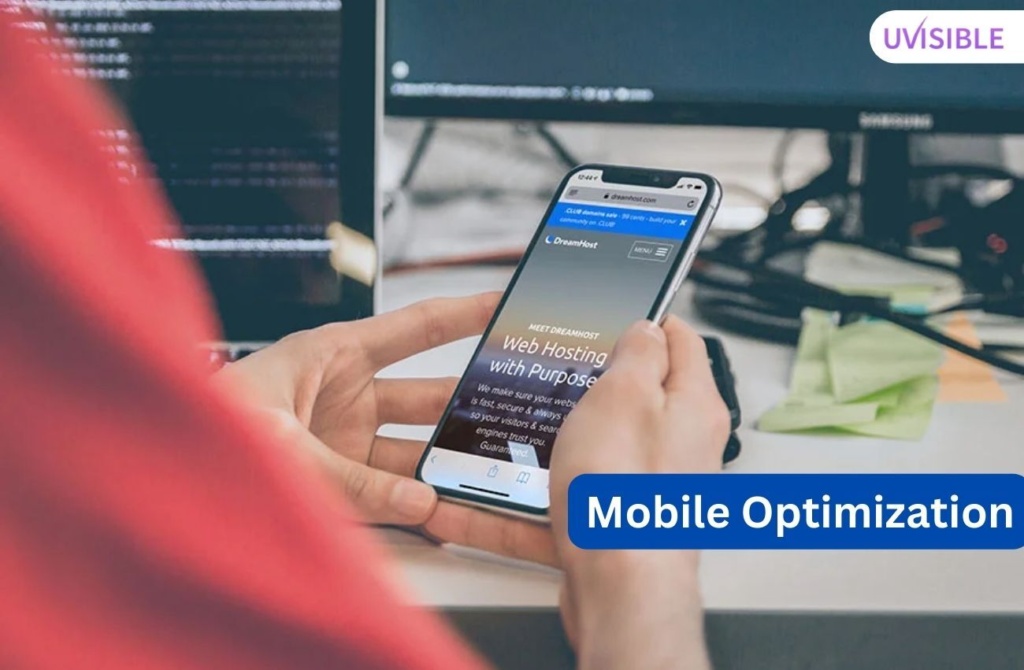
In today’s mobile-centric world, optimizing your website for mobile devices is essential.
A significant portion of website traffic comes from mobile users, and if your website is not mobile-friendly, visitors are more likely to bounce.
Ensure that your website is responsive with a design that adapts seamlessly to different screen sizes.
Optimize images and content for faster mobile loading times, and provide a user-friendly experience on mobile devices. For this, you can even rely on or hire a performance-driven Mobile App Marketing Services Agency.
By catering to mobile users, you can effectively reduce bounce rates and keep visitors engaged.
Streamline Navigation for Seamless Exploration
Easy and intuitive navigation is crucial for reducing bounce rates.
Visitors should be able to find the information they’re looking for without confusion or frustration.
Evaluate your website’s navigation structure and ensure it is user-friendly.
Use clear and descriptive labels for your menu items and ensure that visitors can easily access different sections or pages.
Implementing a search function can also facilitate navigation and reduce bounce rates.
Engage Audiences with Captivating Visual Content
Visual content, such as videos or web stories, can capture visitors’ attention and increase engagement.
Consider incorporating engaging videos that showcase your products or services, provide valuable information, or tell a compelling story.
Web stories, a popular format for visual storytelling, can be used to create interactive and immersive experiences for visitors.
By leveraging visual content effectively, you can enhance user engagement and reduce bounce rates.
Forming Consumer Trust with E-A-T Concept
Building consumer trust is crucial for reducing bounce rates and increasing conversions.
Implement the E-A-T concept, which stands for Expertise, Authoritativeness, and Trustworthiness, to establish credibility with your audience.
Ensure that your website provides accurate and reliable information, showcases credentials or certifications, and includes testimonials or case studies.
By building trust, visitors are more likely to stay on your website and engage with your content.
Quick Site Search
Implementing a site search function allows visitors to quickly find specific information or products, reducing bounce rates.
Make the search bar easily visible and ensure that it provides accurate results.
Enhance Readability with Shorter Paragraphs

Long paragraphs can be overwhelming and discourage visitors from reading the content.
Break down your content into shorter paragraphs to improve readability and make it more scannable.
Check for Broken Links
Broken links can frustrate visitors and prompt them to leave your website.
Regularly check for broken links and fix them promptly to maintain a smooth browsing experience.
Forming Interactive 404 Pages
When visitors encounter a broken link or a page that doesn’t exist, a well-designed and interactive 404 page not found can retain their attention and redirect them to relevant content.
Include a search bar, related links, or a playful message to engage visitors and reduce bounce rates.
Remember, implementing these strategies should be a continuous process.
Regularly analyze bounce rates, and user behavior, and gather feedback to make data-driven improvements.
By focusing on reducing bounce rates, you can increase visitor engagement, improve conversions, and drive the success of your digital marketing efforts.
Analyzing Bounce Rate
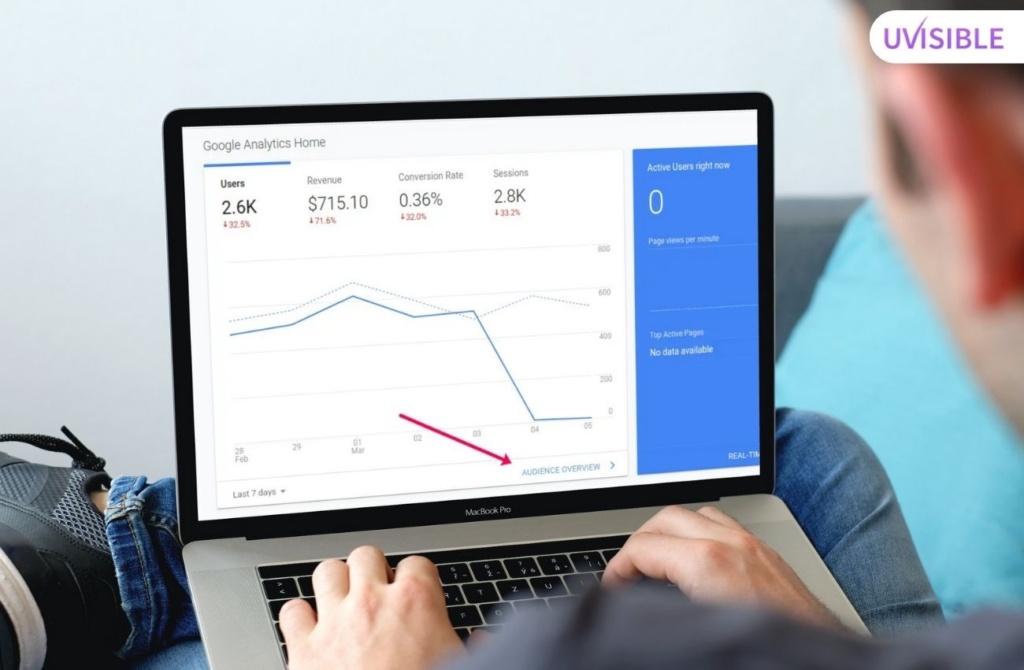
Understanding how to analyze bounce rates is critical for enhancing the performance of your website and increasing user engagement.
Are you prepared to explore the realm of bounce rate analysis?
Let’s look at how you can use statistics to make data-driven decisions to lower bounce rates and keep visitors engaged.
Analyzing Bounce Rates with Tools like Google Analytics
To effectively analyze bounce rates, you need the right tools in your digital marketing arsenal.
One of the most powerful tools available is Google Analytics.
To understand how to reduce bounce rate in Google Analytics, you need to first explore the wealth of information it provides.
By integrating Google Analytics with your website, you can access valuable metrics and reports to gain a deeper understanding of how visitors interact with your content.
With Google Analytics, you can track bounce rates for different pages, identify high bounce rate pages that need attention, and uncover patterns in user behavior.
By examining metrics like average session duration, pages per session, and bounce rate, you can paint a comprehensive picture of your website’s performance.
Let’s walk through the steps of analyzing bounce rates using Google Analytics:
- Accessing Bounce Rate Data
Navigate to Google Analytics’ “Behaviour” section and choose “Site Content,” then “Landing Pages” or “All Pages.”
You’ll discover useful information regarding the bounce rates of your website’s pages here.
- Understanding Bounce Rate Metrics
Pay attention to the “Bounce Rate” measure, which reflects the percentage of visitors that abandon your site after just reading one page.
Remember that a high bounce rate does not always signal an issue.
It might be as a result of visitors swiftly discovering what they need and leaving satisfied.
- Setting Time Period and Segments
To analyze bounce rates over a certain time period, change the time period. Segmentation can also be used to acquire deeper information.
To see how different channels contribute to your bounce rate, segment your data depending on traffic sources such as organic search, social media, or paid advertising.
The Power of Segmentation
Segmenting your bounce rate data is like to put on a detective’s magnifying glass—it reveals hidden patterns and delivers actionable information.
Let’s look at the significance of segmenting bounce rate data depending on several factors:
- Traffic Sources
Analyse bounce rates by traffic source to see which channels are bringing in the most engaged visitors.
Visitors from organic search, for example, may have lower bounce rates than those from social media.
This knowledge can help you direct your marketing efforts and allocate resources more efficiently.
- Landing Pages
Bounce rates on various landing pages should be evaluated to identify areas for development.
Are there any sites that have a high bounce rate?
Understanding visitor behavior on landing pages allows you to optimize their design, content, and calls to action to drive deeper interaction.
- Devices
To identify any differences, segment bounce rates based on devices, such as desktop, mobile, and tablet.
Mobile users’ surfing habits may differ, and knowing their experiences may help you optimize your website for mobile responsiveness and user engagement.
- Demographics
Investigate bounce rate statistics depending on demographics like age, gender, or geography to learn more about certain audience groups.
This data may assist you in tailoring your content, message, and user experience to better resonate with various demographic groups.
Interpreting Bounce Rate Data Effectively
While analyzing bounce rates is necessary, it is also essential to correctly understand the data to make educated judgments.
Here are some crucial points to remember:
- Consider Context
Bounce rate data should be analyzed concerning the aims and objectives of your website.
Depending on the goal of the website or campaign, a high bounce rate may be acceptable or even desirable.
A blog post with a high bounce rate, for example, may still be useful if it receives direct visitors and raises overall blog traffic.
- Complement with Other Metrics
Analyse bounce rate statistics with other metrics like time on page, exit pages, conversion rates, and user flow to acquire a full insight.
These metrics give useful information and aid in the identification of trends and patterns in visitor behavior.
- Test and Iterate
Bounce rate analysis is a constant testing and development process.
Make data-driven optimizations to your website, landing pages, content, and user experience using the insights gathered.
Test various tactics, track their influence on bounce rates, and iterate as needed.
Now that you’ve mastered the investigative abilities required to accurately analyze bounce rates, it’s time to put your newfound knowledge to use.
Remember that the journey does not end here—constant analysis and optimization are essential for lowering bounce rates and increasing user engagement.
So, channel your inner detective, harness the power of Google Analytics, and uncover the mysteries buried in your bounce rate statistics.
Measuring Success and Tracking Progress

In this section, we will delve into setting realistic goals, tracking progress, and monitoring important metrics alongside bounce rate.
Let’s explore how these steps can help you effectively reduce bounce rates and improve your website’s performance.
Setting Realistic Goals and Tracking Progress
Reduced bounce rates necessitate a well-defined approach and attainable targets. Here are some tips to help you succeed:
- Understand Your Baseline
Begin by examining your existing bounce rate and identifying opportunities for improvement. This will be your starting point against which you will assess your development.
- Set Specific and Attainable Goals
Set specific and quantifiable targets for lowering your bounce rate. Rather than creating high expectations, aim for steady gains.
For example, you may aim to reduce your total bounce rate by 10% during the next quarter.
- Break Down Goals
Break down your overall aim into smaller milestones. Improve bounce rates on certain landing pages, for example, or target a specific traffic source.
- Track Progress Over Time
Monitor and analyze your bounce rate statistics regularly to gauge progress.
Track changes in your bounce rate, and segment data, and receive insights into the efficacy of your tactics with tools like Google Analytics.
Monitoring Key Metrics Alongside Bounce Rate
While bounce rate is an important measure, it is also important to evaluate other key performance indicators (KPIs).
Here are a few measures that might help you understand user engagement and website performance:
- Page Views
This indicator tracks how much time visitors spend on your website’s pages.
Monitoring time on the page allows you to determine whether or not visitors are engaged with and find value in your material.
The longer duration on the page frequently signals more engagement and lesser bouncing.
- Conversion Rate
The percentage of visitors who perform a desired activity, such as completing a purchase, filling out a form, or subscribing to a newsletter, is referred to as the conversion rate.
Conversion rates, when tracked, offer a more complete picture of user behavior and the efficiency of your website bounce rate in driving conversions.
- Average Session Duration
This indicator computes the average time visitors spend on your website during a session.
A longer average session time indicates that visitors are browsing many pages and engaging with your material, which decreases the likelihood of bouncing.
- Bounce Rate by Traffic Source
Analyzing bounce rates depending on traffic sources such as organic search, social media, and paid advertising allows you to better understand the quality and relevancy of visitors from each channel.
It allows you to concentrate your efforts on channels that attract engaged visitors with lower bounce rates.
Remember that measuring these indicators with the bounce rate offers a more complete picture of user engagement and website performance.
You may fine-tune your methods, improve user experience, and eventually minimize bounce rates by analyzing these indicators.
From Our Point of View!

Finally, understanding and efficiently lowering bounce rates is an important component of digital marketing and website optimization.
You may improve user experience, boost engagement, and eventually generate more user traffic to your website by applying the methods and tactics outlined in this article.
How to reduce bounce rate in Google Analytics Using tools like Google Analytics to analyze bounce rates helps you to acquire useful insights into user behavior and make data-driven decisions.
To find patterns and identify areas for development, remember to separate bounce rate data depending on traffic sources, landing pages, devices, and demographics.
Improving website speed, design, and performance, improving user experience, generating relevant and interesting content, optimizing landing pages, and adopting A/B testing are just a few effective methods for lowering bounce rates.
Other measures, such as utilizing exit intent strategies, clever internal linking, and emphasizing visual content, can also help to improve user engagement and reduce bounce rates.
Set reasonable targets for lowering bounce rates, analyze your success over time, and keep an eye on other important metrics like time on page, conversion rate, and average session duration.
These indicators give a full picture of user engagement and your website’s efficacy in driving conversions.
You can improve website traffic, attract more users, and provide a good user experience by using these methods and monitoring the website bounce rate.
Reduced bounce rates are critical for success in the digital marketing landscape, whether you run a blog, an e-commerce site, or any other form of website.
So, start implementing the thoughts and expertise you’ve obtained from this blog on your website.
Remember that lowering bounce rates is a continual activity that involves regular analysis, optimization, and adaption.
By continually boosting user engagement and refining your techniques, you will pave the path to more success in your digital marketing endeavors.
Now that you’ve learned about bounce rates, landing page optimization, and the power of analyzing website traffic, you’re ready to conquer the digital world with a lower bounce rate and higher engagement!
Thank you for coming along with us on this adventure.
Best wishes in your attempts to lower bounce rates and increase traffic to your website.
Experience the power of effective digital marketing services with Uvisible, the dedicated and result-oriented Digital Marketing Agency.
Take your online presence to new heights and achieve your business goals.
Contact us NOW for a FREE CONSULTATION!
About us and this blog
We are a digital marketing company with a focus on helping our customers achieve great results across several key areas.
Request a free quote
We offer professional SEO services that help websites increase their organic search score drastically in order to compete for the highest rankings even when it comes to highly competitive keywords.
Subscribe to our newsletter!
More from our blog
See all postsRecent Posts
- A Guide for “How to Manage and Measure Local PPC Accounts” November 30, 2024
- A Guide to Help You Write High-Quality Blog Content November 21, 2024
- 10 Hidden SEO Tips to Outsource Enterprise SEO November 19, 2024





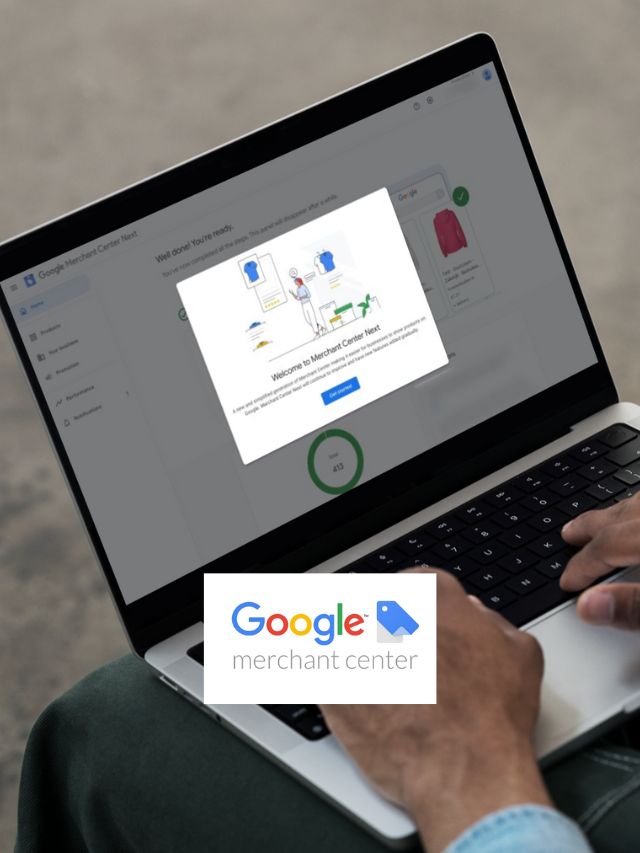








Pingback: Make SEO-Friendly Web Design for Massive Traffic: 9 Tips
Pingback: Key Performance Indicators (KPIs) for Measuring SEO Success
Pingback: Landing Page Optimization: The Ultimate Guide - Uvisible